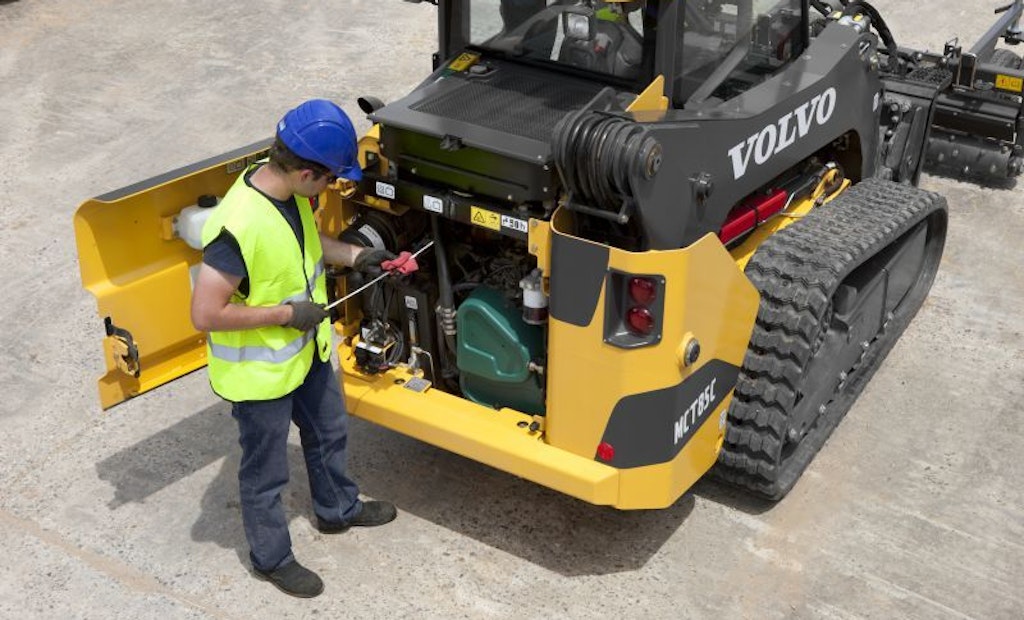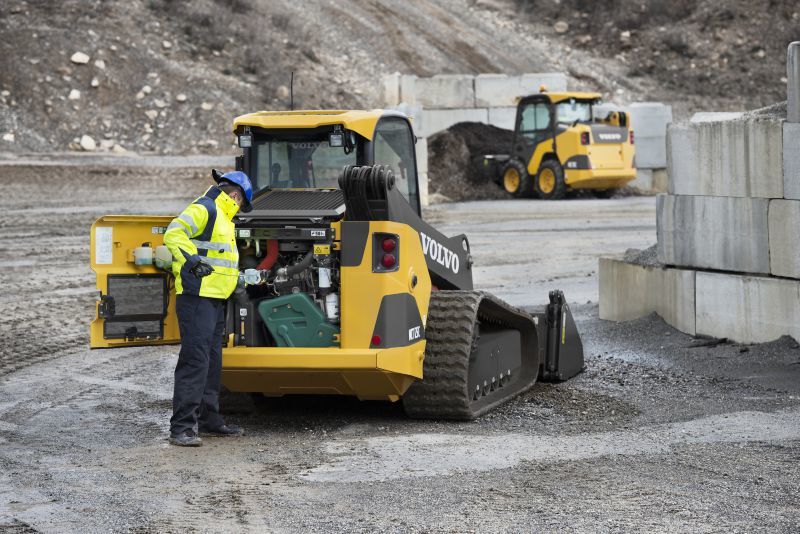
General maintenance should be performed on compact excavators regularly. Here, maintenance is performed on a Volvo MCT85C compact track loader. (Photos courtesy of Volvo Construction Equipment)
Interested in Excavating?
Get Excavating articles, news and videos right in your inbox! Sign up now.
Excavating + Get AlertsSimilar to trucks and other large pieces of equipment, delaying or ignoring regular maintenance on compact track loaders can lead to big headaches and large repair bills. When operators do not keep up with routine maintenance, it can lead to unplanned machine downtime, which can be costly and frustrating.
“Daily maintenance is cheaper than letting the system go,” says Buck Storlie, testing and reliability leader for ASV Holdings, a manufacturer of compact track loaders.
Without regular maintenance, problems with the engine and transmission can also develop and machine components receive excessive wear. “Stay on top of service intervals, and make sure that the operators are conducting a daily walk around to make sure the machine is in good shape,” says Kevin Scotese, a product manager with Volvo Construction Equipment.
Since proper maintenance is so important to compact track loaders, experts share their advice on how contractors can keep their equipment running:
1. Establish and follow a maintenance schedule
Like any service equipment, manufacturers include a suggested maintenance schedule that contractors are recommended to follow. “The machine’s operation and maintenance manual provides maintenance intervals for fluids, lubricants and filters,” says Christopher Girodat, a marketing manager with Bobcat.
Typical service guidelines recommend changing the oil on a compact loader after 500 hours of work and greasing after every 50 hours of use.
“The single biggest thing that contractors forget is greasing,” Scotese says. “People forget to grease pins and bushings, which creates big problems over time. After wearing out, they can bend components like hydraulic cylinders, causing a need for repair. This is something that could have easily been avoided in the first place simply by greasing.”
The maintenance schedule should also include checking other fluids along with the radiator and air filters.
“You need to make a habit of it, either at the end of a shift or at the start of one,” Storlie says. “We work in dirty conditions, and if you are not paying attention to the radiator, for example, the machine could overheat.”
2. Check the undercarriage
The undercarriage is the hardest working part of the loader, and a general inspection of the area is always a good idea. “Check track tension and the sprocket system, and always remember to clean it out,” Storlie says. “If it is not in top working order, the whole machine is affected.”
Cleaning out the undercarriage and related components can prevent debris from freezing in place if the temperature drops too low. “Shovels and pressure washers may be used to clean the undercarriage area to ensure the compact track loader is ready,” Girodat says.
As part of the undercarriage inspection, contractors should routinely inspect the drive motor, drive sprockets, main idlers and rollers, rock guards, track bolts, track chains and track shoes, Girodat adds.
3. Watch where you drive
Caring for the tracks is essential with compact track loaders. Scotese advises contractors to not turn on asphalt or concrete or go over curbs, which wears out the tracks more quickly.
The machines are best used primarily on softer ground like grass, dirt or mud.
4. Remember to check the attachments
Many contractors overlook their compact track loaders’ attachments and components, such as a bucket’s cutting edges, shanks and hydraulic hoses.
“Operators should replace any worn or damaged pins or teeth to help maintain productivity and minimize machine or attachment downtime,” Girodat says.
Storlie says checking attachments daily will also help operators determine if wear is developing or any damage has occurred.
5. Store equipment properly
Operators will also benefit from keeping their compact loaders inside to protect them from the weather, especially during the winter months. Keeping the machine inside will help it stay warmer and protect it from snow and ice.
6. Use the correct fuel
Manufacturers say operators should also pay attention to the quality of the diesel fuel they are placing in their compact track loaders. Newer machines require ultralow sulfur diesel fuel, which burns cleaner, hotter and more efficiently. If contractors use the wrong fuel, the machine could be damaged or not run as effectively.
7. Check track tension
Regular track maintenance includes checking for proper tension, cleaning and inspecting the equipment. When the tension is incorrect, it leads to increased track wear, which shortens the life of the equipment, Storlie says.
If the tension is too loose, the tracks can fall off. And if the tension is too tight, the idlers and sprockets can be damaged. “A quick check will make sure levels are correct,” Storlie says.






